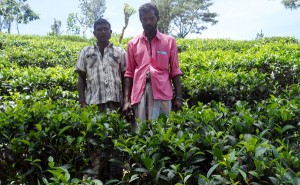Crisis-hit Lankan tea industry needs re-engineering : Forbes report
View(s):A call for re-engineering in Sri Lanka’s tea industry given the high and uncompetitive cost of production has been made by the country’s tea broker.
Forbes and Walker Ltd, in its annual 2012 report which contains the tea performance for the year and projections in 2013, said while tea prices are projected to be buoyant this year or at least during the 1st half of 2013, the industry needs “for the long term sustainability, re-engineering to achieve global competitiveness since Sri Lanka’s cost in producing a kilo of tea is amongst the highest in the world.”

File photo shows plantation workers
The report said rising input costs, declining worker productivity, tea bushes becoming uneconomic due to age profile and high social costs have lead to decline in profits more often. “Perhaps, higher productivity and cost reduction will have to be achieved for enhancing competitiveness of ‘Ceylon Tea’ in the world market in the medium to long term. Therefore, global competitiveness of ‘Ceylon Tea’ will largely depend on how quickly the industry addresses these vital issues,” Forbes said.
The advice on re-thinking the future structure of the tea industry is not new and has been discussed by stakeholders over the past few years. Recently one plantation company announced an outgrower scheme where employees take care of the tea bushes and also harvest the tea leaves and are paid according to a standard, transparent formula.
Discussing the tea market this year, Forbes said the re-entry of Pakistan, a significant player in the market, is a key development as far as Sri Lanka is concerned.
Here are excerpts of the report:
Outlook in 2013
In analyzing the global supply position at the end of 2012, it is conclusive that the deficit of 50 – 60 million kgs, as at mid 2012 has narrowed considerably and, as at end 2012 is possibly a deficit of only 20-30 million. This scenario is unlikely to change in the immediate future, as it is customary in almost all producing countries where production levels are generally low in the first quarter.
Going into 2013, the robust market conditions that prevailed for high and medium grown teas during the third and fourth quarters of 2012 is most likely to continue up to end of current quarter.
The current prices for low grown leafy teas appear good value in US$ terms when compared to the price structure in 2011. This trend could be attributed to the volatile trading conditions that have prevailed in our key markets in the Middle Eastern region– particularly Iran and Syria.
Performance in 2012
The year began with optimism on the back of a high GDP growth rate in 2011 along with low interest rates and low inflation. The Lankan currency too was trading at a position of relative strength in comparison to the US Dollar. The predictions for 2012 too were very positive with the economic growth expected to remain at around the eight per cent levels. However by early February the signs of balance of payment issues cropped up and the currency which was at a very stable level of around Rs. 113 to 114 began to lose value. Correspondingly the interest rates which began the year at around 12 per cent slipped to over 14 per cent by the close. The impact of these was felt on consumer prices and inflation which was at a very low rate in January climbed significantly within the last 12 months. The economy did not maintain the expected growth levels and is expected to end the year at a GDP growth of around 6.5 per cent.
Exchange rates
The LKR-USD middle rate on 1st January 2012 was Rs 113.79. It was hovering around these rates until the 7th of February when the tight control over the rate was relaxed. The rate then slipped to 119.50 by 16th February and to 130 by 23rd March 2012. It peaked at 133.91 on 15th July 2012, and then has gradually strengthened since then. The yearend middle rate was 126.93. Overall we therefore see a rupee devaluation of 12 per cent for the year.Interest rates
The average weighted lending rate of all commercial banks was 10.49 per cent in the 1st week of January. There was a very gradual increase of the rates and we have seen an interest hike to date.
Follow @timesonlinelk
comments powered by Disqus




















